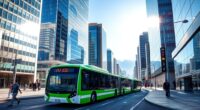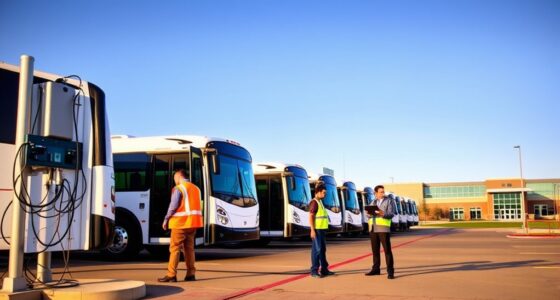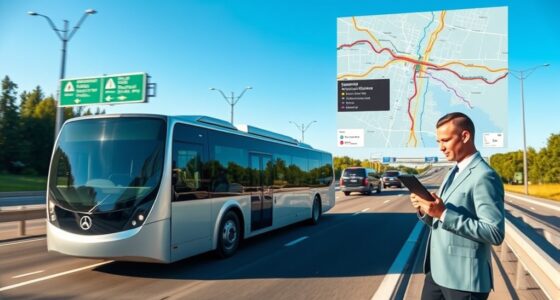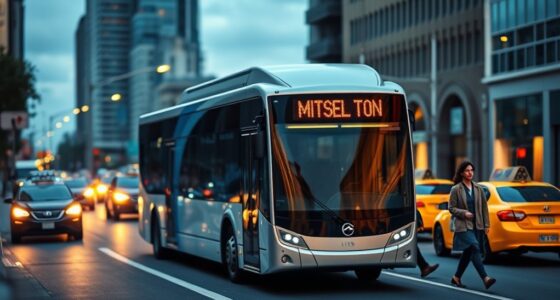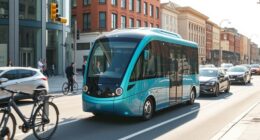Over the past two years, Norway has successfully integrated Karsan’s Level 4 autonomous E‑Atak into urban transit, showcasing its ability to navigate busy city streets safely and efficiently. The deployment highlights Norway’s supportive regulation, electric powertrain, and focus on safety, helping to reduce congestion and emissions. This initiative proves autonomous vehicles can become part of city life, paving the way for smarter, cleaner mobility. To discover how this groundbreaking project continues to evolve, keep exploring.
Key Takeaways
- Norway’s regulatory environment enabled two years of safe, Level 4 autonomous operation of Karsan’s E-Atak in urban settings.
- The autonomous E-Atak has effectively improved traffic flow, reduced congestion, and promoted sustainable, electric urban mobility.
- Extensive testing and safety standards have built public trust and demonstrated the vehicle’s reliability in complex city environments.
- Deployment highlights Norway’s role as a leader in autonomous vehicle innovation and its supportive legal framework.
- The success supports future expansion of autonomous solutions, advancing smarter, cleaner urban transportation worldwide.

Norway has recently become the testing ground for Karsan’s innovative Autonomous E‑Atak, marking a significant step toward the future of urban transportation. As you observe this development, you recognize how the vehicle’s deployment is reshaping urban mobility by introducing a new level of efficiency and safety. The Autonomous E‑Atak operates at Level 4, meaning it can steer through complex city environments without human intervention, allowing cities to rethink their public transit systems and reduce congestion. This advancement isn’t just about technology; it’s about creating smarter, more sustainable cities where people can travel more freely and reliably.
Norway’s testing of Karsan’s Autonomous E‑Atak advances smarter, safer, and more sustainable urban mobility.
You might wonder how Norway’s environment supports such cutting‑edge mobility solutions. The country’s progressive approach to autonomous vehicle regulations plays a vital role. Norway has established clear and flexible frameworks that promote testing and deploying autonomous vehicles, ensuring safety standards are met while encouraging innovation. These regulations provide the necessary legal certainty, giving companies like Karsan the confidence to test their vehicles on public roads. By fostering a collaborative environment between policymakers, technology developers, and the public, Norway makes it easier for autonomous vehicles to integrate into daily urban life. Additionally, Norway’s focus on safe backup systems helps ensure reliability and safety during the deployment of autonomous vehicles.
As you follow the progress of the Autonomous E‑Atak, you notice how its deployment aligns with Norway’s goals for sustainable urban mobility. The vehicle’s electric powertrain drastically reduces emissions, contributing to the country’s climate commitments. Its autonomous capabilities optimize traffic flow, decrease unnecessary stops, and improve overall efficiency. You can see how this impacts not only environmental goals but also the quality of life for residents, who experience less noise and air pollution while benefiting from more reliable public transport options.
Moreover, the autonomous vehicle regulations in Norway guarantee that safety remains paramount. You understand that before widespread adoption, the vehicle underwent extensive testing, data collection, and adherence to strict legal standards. These measures help build public trust, which is essential for the acceptance of autonomous technology. As you witness the vehicle navigating busy streets seamlessly, it’s clear that Norway’s regulatory environment supports innovation while prioritizing safety and accountability.
In the end, your perspective is that the Autonomous E‑Atak’s success in Norway isn’t just about technological achievement; it’s a proof of how thoughtful regulation and forward-thinking urban planning can work together. The two-year operation demonstrates that autonomous vehicles can become a practical part of city life, paving the way for a future where urban mobility is smarter, cleaner, and more accessible for everyone.
Frequently Asked Questions
How Does the Vehicle Handle Extreme Weather Conditions?
You’ll find that the vehicle handles extreme weather conditions well thanks to advanced sensor calibration and weather adaptation features. Its sensors adjust to changing conditions, ensuring reliable operation even in snow, rain, or fog. The vehicle’s system continuously monitors environmental factors, allowing it to adapt seamlessly and maintain safety. This resilience makes the autonomous E‑Atak dependable, providing consistent performance regardless of harsh weather challenges.
What Is the Passenger Capacity of the E-Atak?
Imagine the E-Atak as a cozy shuttle, comfortably fitting around 15 passengers. Its design prioritizes passenger comfort, ensuring smooth rides even in harsh weather. When you board, farewell protocols guide your seamless entry and exit, making every trip feel effortless. Whether you’re with friends or solo, this vehicle’s capacity balances space and intimacy, making it ideal for both daily commutes and special journeys.
Are There Backup Systems for System Failures?
Yes, there are backup systems in place for system failures. You’ll find autonomous diagnostics that continuously monitor the vehicle’s systems, alerting you to potential issues before they escalate. In addition, backup protocols automatically activate essential functions if a primary system fails, ensuring safety and continuity. This layered approach helps maintain reliable operation, giving you confidence that the vehicle can handle unexpected system issues smoothly and efficiently.
How Is Passenger Safety Ensured During Autonomous Operation?
You’re kept safe during autonomous operation through advanced safety features that prioritize passenger comfort. The system continuously monitors surroundings and vehicle performance, automatically engaging emergency procedures if needed. Backup systems are in place to handle system failures, ensuring smooth operation. These measures help you feel secure, knowing that safety protocols and emergency responses are seamlessly integrated, allowing you to enjoy a comfortable, stress-free autonomous ride.
What Are the Future Expansion Plans for Autonomous Routes?
You’ll see expansion plans focus on integrating autonomous routes into urban infrastructure, making transportation more efficient. To do this, you’ll need to navigate regulatory challenges by working closely with authorities to develop standards and safety protocols. Future routes will likely extend into new city areas, improving accessibility and reducing congestion. As these plans unfold, you’ll experience smarter, more connected transportation that adapts to evolving urban needs.
Conclusion
As you watch the Karsan Autonomous E-Atak carve through Norway’s icy roads, it’s like witnessing a brave explorer charting new territory in a frozen wilderness. After two years of Level 4 operation, you see innovation blooming like a northern aurora—vivid, resilient, and illuminating the future of autonomous transport. This journey proves that with each mile, technology becomes more confident, transforming icy challenges into a clear highway toward tomorrow’s mobility.

